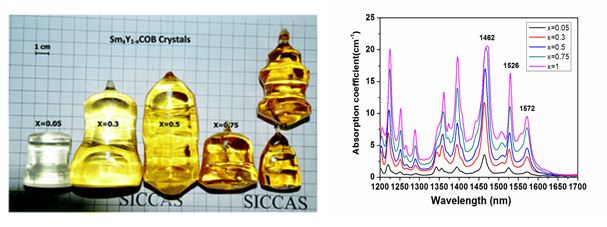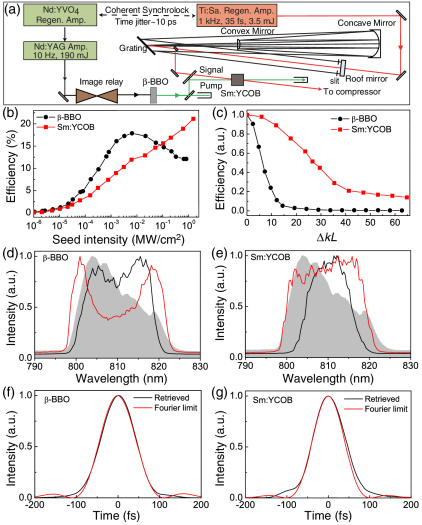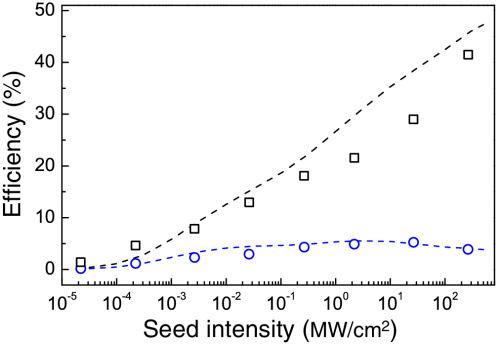Sm:YCOB crystals first used in a new concept of laser experiments
New concept laser technology has been demonstrated by Professor Liejia Qian’s group in Shanghai Jiao Tong University (SJTU), based on the novel Sm:YCOB crystals developed by the nonlinear optical crystal research group in Shanghai Institute of Ceramics, Chinese Academy of Sciences (SICCAS), recently. Amplification of broadband chirped pulses, corresponding to a pump depletion of 70% and an inner signal efficiency of 47%, has been achieved in a typical Gaussian pump case, exceeding the efficiency of the previously reported state-of-the-art OPA (Optical parametric amplification) experiments, reaching the high level of conversion efficiency of the conventional SHG and THG, and was published by OSA (Optica 2015, 2 (11), 1006-1009).
Broad gain bandwidth and high conversion efficiency are two key characteristics of ideal high power laser, and determine the peak power. Currently, intense chirped-pulse amplification (CPA) lasers rely on two distinct types of optical amplifiers: conventional laser amplifiers based on Ti:Sapphire and optical parametric amplifiers, with characteristics of high efficiency and broad bandwidth respectively, however, not being able to keep these two advantages simultaneously. To reach high peak power close to a petawatt, a new concept laser technology, termed “quasi-parametric amplification (QPA)“, has been proposed by Qian’s group. This QPA scheme is a variant of OPA, in which a new type of nonlinear optical crystals (QPA crystals) with strong idler absorption were used to replace the traditional OPA crystals. The depletion of idler will fundamentally inhibit the detrimental backconversion effect and establish an ideal environment for chirped-pulse amplification with high conversion efficiency and broad gain bandwidth. Therefore, in this manner, the signal efficiency approaches the theoretical limit as the input signal and pump intensities are increased, and the backconversion effect is fundamentally obstructed, enabling robust amplification against phase mismatch.
To verify the new concept QPA scheme, novel nonlinear crystals which are highly absorptive at the idler wavelength and transparent at the pump and signal wavelengths must be designed and grown to meet the requirements of QPA firstly. The dedicated nonlinear optical crystal is indispensable for broadband QPA working at the magic phase matching (MPM) wavelength, as noncollinear MPM is not supported in the edge absorption regions by currently available crystals. A novel nonlinear crystal which features high transmittance at around 532 nm and 800 nm and high absorption at around 1572 nm, has been developed in SICCAS, based on the substrate’s nonlinear optical properties, structure compatibility, doping level, segregation effect and other factors. The yttrium calcium oxyborate (YCOB) crystal has been selected as the substrate crystal, because of their excellent nonlinear optical coefficient and large structure compatibility compared to conventional nonlinear crystals such as LBO and BBO. The rare-earth ion Sm3+ has been doped into the YCOB crystal, which led to absorption spectrum covering the idler wavelength of MPM. Growth and properties of Sm:YCOB crystal were published by RSC (CrystEngComm. 2013,15, 6244-6248).
The novel idea of those works will enlighten the design of various frequency conversion processes and QPA crystals used in different wavelengths.

Fig. 1 The photograph of as-grown SmxY1-xCOB crystals with different Sm3+ concentrations (left) and their absorption spectra along the Y-axis direction at the wavelength from 1200 nm to 1700 nm.

Fig.2 (a) Schematic of the experimental configuration, (b) signal efficiency versus seed intensity for OPA (black circles) and QPA (red squares). The seed signal and pump were set to a similar beam size of 5.0 mm × 1.6 mm. (c) Normalized signal efficiency as a function of the phase mismatch ΔkL for OPA (black circles) and QPA (red squares), where both measurements were performed at their highest efficiencies. (d),(e) Recorded signal spectra of OPA (QPA). The black (red) curve corresponds to a seed intensity of 6.5 (325) kW/cm2; the grey region represents the seed signal spectrum. (f ),(g) The compressed and Fourier-limited pulses in OPA (QPA) for a seed intensity of 6.5 (325) kW/cm2.

Fig. 3 Measured signal (squares) and idler (circles) efficiency versus seed intensity for QPA. The black (blue) dashed line is the theoretically predicted signal (idler) efficiency. The seed signal (pump) beam was set to a 800 (620) μm diameter, and the pump intensity was fixed at ~3.0 GW/cm2.
Paper links:
https://www.osapublishing.org/optica/abstract.cfm?URI=optica-2-11-1006
http://pubs.rsc.org/en/Content/ArticleLanding/2013/CE/C3CE40411K



